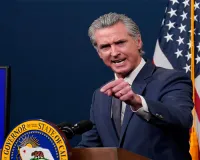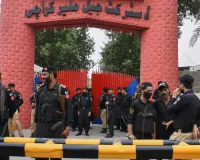US, China begin 2nd day of tariff talks; no breakthroughs but Trump touts 'great progress'
The US and China on Sunday resumed crucial tariff talks that have put the global economy on edge, but appeared to have diverging views of where the negotiations presently stand.
US President Donald Trump wrote on social media that “great progress” was being made and even suggested a “total reset” was a possibility as the sides took their seats for the second and final scheduled day of discussions in Geneva.
Beijing has yet to comment directly, but its official news agency took a tough approach, saying China will “firmly reject any proposal that compromises core principles or undermines the broader cause of global equity”.
Still, Trump wrote Sunday on social media that “great progress” was being made.
He gave no further details, and officials at the White House also offered little information during and after the opening day of discussions.
Two officials speaking to The Associated Press on condition of anonymity because of the sensitivity of the matter confirmed that the talks had resumed on Sunday morning.
The discussions could help stabilise world markets roiled by the US-China standoff that has ships in port with goods from China unwilling to unload until they get final word on tariffs. The discussions have been shrouded in secrecy, and neither side made comments to reporters as they left Saturday.
In its editorial, Xinhua said, “Talks should never be a pretext for continued coercion or extortion, and China will firmly reject any proposal that compromises core principles or undermines the broader cause of global equity.”
Several convoys of black vehicles have been seen coming and going from the residence of the Swiss ambassador to the UN delegation in Geneva, which hosted the talks aimed at de-escalating trade tensions between the world's two biggest economies.
Trump last month raised US tariffs on China to a combined 145%, and China retaliated by hitting American imports with a 125% levy. Tariffs that high essentially amount to the countries' boycotting each other's products, disrupting trade that last year topped USD 660 billion.
Even before talks got underway, Trump suggested Friday that the US could lower its tariffs on China, saying in a Truth Social post that “80% Tariff seems right! Up to Scott!" — referring to lead negotiator and Treasury Secretary Scott Bessent.
The talks mark the first time the sides have met face-to-face to discuss the issues. And though prospects for a breakthrough are slight, even a small drop in tariffs, particularly if taken simultaneously, would help restore some confidence.
“Negotiations to begin de-escalating the growing US–China trade war are badly needed and it's a positive sign that both sides were able to gracefully move beyond their bickering over who had to call first,” Jake Werner, director of the East Asia Program at the Quincy Institute for Responsible Statecraft, said in an email.
The tariff fight with China has been the most intense. Trump's tariffs on China include a 20% charge meant to pressure Beijing into doing more to stop the flow of the synthetic opioid fentanyl into the United States.
The remaining 125% involve a dispute that dates back to Trump's first term and comes atop tariffs he levied on China back then, which means the total tariffs on some Chinese goods can exceed 145%.
China's trade deficit, which came to a record $263 billion last year, has also been a major target of Trump's complaints.









